Llano in the Wild: Toshiba's Satellite L775D-S7206
by Dustin Sklavos on August 12, 2011 12:45 AM ESTRunning Cool and Quiet
One of Jarred's big takeaways and certainly one of the things AMD representatives are the most proud of is the vast improvement in power consumption and heat that Llano brings, and that's where you're really going to see the difference with the Toshiba Satellite L775D-S7206.
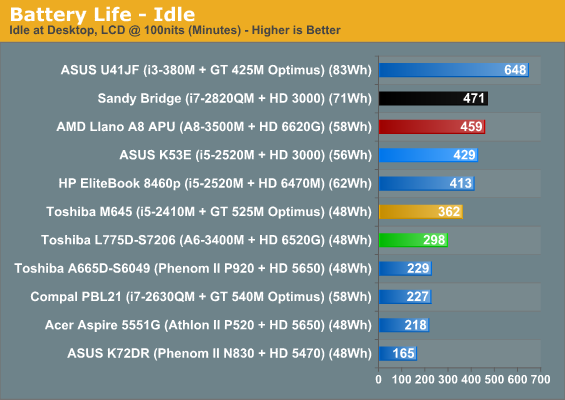
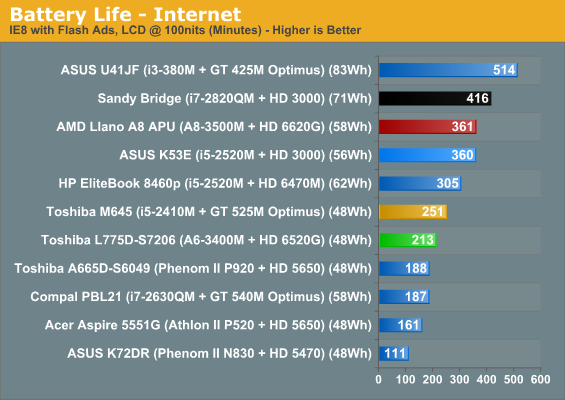
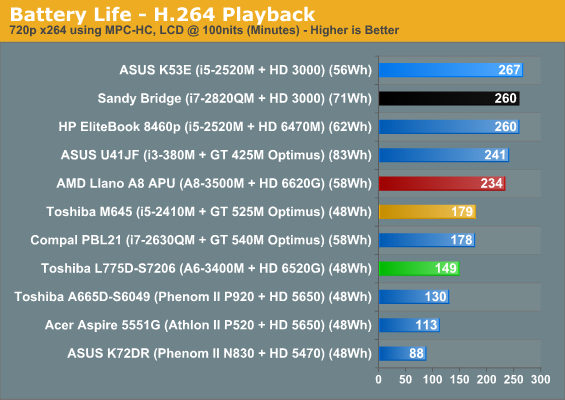
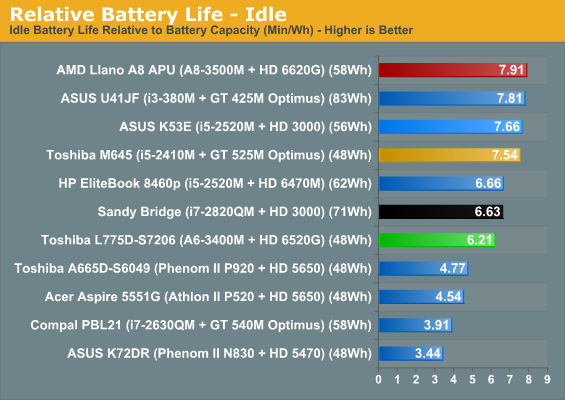
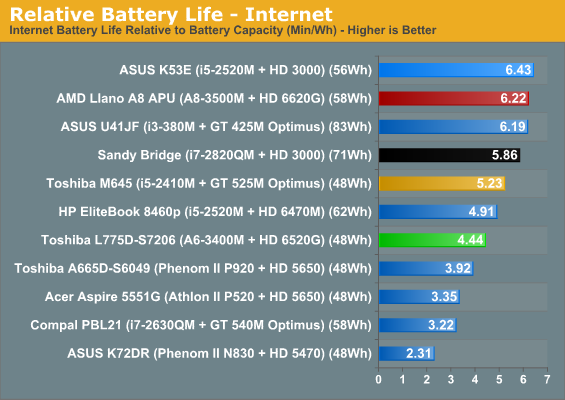
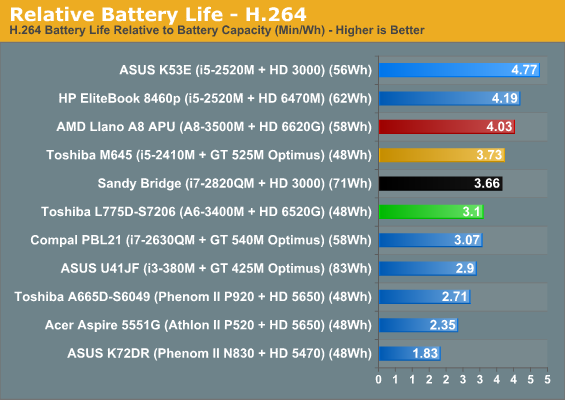
The A6-3400M unfortunately still has trouble keeping up with Sandy Bridge and Optimus, but it's a massive improvement on AMD's last generation. The A8 test laptop also performed much better in battery life, a combination of the smaller 14" panel and higher capacity battery. Despite the meager battery Toshiba equips the L775D-S7206 with, it still manages to produce solid running time, keeping in mind that many of these competing notebooks aren't saddled with having to power a 17" screen on top of everything else.
As for noise, the L775D-S7206 is actually blissfully quiet even under sustained load. At a meeting with HP and AMD in San Francisco a couple of months back to discuss the impending Llano launch, the AMD rep was keen to have the press touch some of the Llano-equipped laptops there just to feel how cool they were running, and he was right. Toshiba's notebook barely warms up, and the fan barely has to spin up. This, at least, is a major coup and step forward for AMD.

Those temperatures are incredibly frosty. The "THRM" temperature at the top is actually the overall CPU temperature, and it runs as cool as or cooler than I've seen Arrandale or Sandy Bridge run in most of the notebooks I've reviewed. The 17" chassis certainly does a lot of the work for Toshiba, but the end result is a notebook that's both cool and quiet.










74 Comments
View All Comments
alxnet - Friday, August 12, 2011 - link
There's a number of 30% off or $300 off coupons floating around which gets you a substantial discount off a minimum $1000 custom laptop purchase from HP. Just google HP-30%-Coupon. Got my 9cell dv6z with an A8-3500 and a 1920x1080 screen for under $800. I've got a OEM Vertex 3 240GB which I got for less than $400 after rebate. Combined, it's one hell-uv-a laptop. Eight hours of runtime on average and it boots so quick I don't even bother putting it into sleep mode.JarredWalton - Friday, August 12, 2011 - link
Yeah, that's pretty slick. The SSD is of course a huge upgrade, but even without it, $800 for that sort of setup is far better than most $800 laptops you normally find. Since I'm not usually in the market for buying laptops, I don't scour around for coupons much. Maybe we need a guy dedicated to doing that and making little Pipeline posts? :-)Novaguy - Saturday, August 13, 2011 - link
My HP A8-3530MX system was $820 pre-tax/shipping using one of the 30% coupon, like alxnet mentioned. Base configuration price was $50 at the time (I should demand a price correction) but that works out to a $35 difference once you factor in the coupon. Not worth the aggravation of spending a couple hours on the phone with customer service.If I had to do it again, I might have aimed the processor lower (an A8-3510MX, probably) and maybe skipped the 6750M (maybe, it's kind of fun to have it just to see if it ever works).
I wouldn't skip the 1080p, though. It's my must buy upgrade, especially since the HP comes with blue-ray and one of things I use the laptop for is a portable DVD/blue ray player for when I travel. One negative - just like the toshiba here, HP has glossy plastic crap on the bezel. Why?
Also, I think that the 30% coupon only kicks in at the 999.00 base price, so when you get close, there is an incentive to get over it.
Shadowmaster625 - Friday, August 12, 2011 - link
If it runs cool then it should be overclocked. If it cannot be overclocked then it is useless. Again, the benchmark results seem to indicate that the chip only turbos up to 1.8GHz. Clearly the turbo is not functioning as it should.JarredWalton - Friday, August 12, 2011 - link
I'd say the Turbo is functioning exactly as expected. 2.3GHz is the max it can hit, but just like Intel I'm guessing you mostly won't get max -- maybe max minus a bin or two. Then again, with a 17.3" chassis the CPU ought to have more than enough cooling to be able to run faster. Personally, though, I don't believe in overclocking laptops at all. They may work fine for six months, or even two years, but most laptops already start to run pretty toasty when you start running games or other CPU/GPU intensive apps. I never find laptops to be so slow that I'd worry about a 10% overclock, and 33% usually pushes too far (outside of CULV, where that just made a CULV into a slightly lower clocked Core 2).DudleyUC - Friday, August 12, 2011 - link
I know companies like things in sets of 3, but I'm not sure there's a lot of need for the A6. The A4 gives you 2 cores at a higher clock (1.9 GHz) translating into better performance on single threaded CPU applications. It also gives you a faster clock (444 MHz) but on fewer shaders, yielding only slightly lower graphics performance.If you need 4 cores, it's not that much extra money for an A8 that gives you slightly better CPU performance than the A6 and substantially improved graphics performance.
So what niche does the A6 fill? Does the lower clocked GPU improve battery life? Is this just a marketing tactic (appealing to customers who don't want buy the cheapest option or the most expensive option)?
silverblue - Friday, August 12, 2011 - link
I think I can agree on this one. A proper (read: not with disabled cores) dual core Llano would result in less power usage and lower temperatures, so they could easily afford to throw out a much higher clocked variant. The productivity scores wouldn't suffer (they might actually be an improvement) as long as the Turbo Core implementation isn't significantly reduced.Having said that, I still can't help but wonder what a different cache implementation would achieve - unified L2 isn't an AMD thing so we can rule that out, but some L3 cache, perhaps? We've also learned that fast, low latency RAM is a big help for APU performance, and with the relative proximity in terms of pricing, the only thing you'd need to worry about with faster RAM would be the power usage... but again, if we're going dual core, that's nicely offset provided you don't go completely mad with the CPU clock. Manufacturers also have to remember that, with a discrete-level card, we can't have anaemic batteries on these machines, something we saw all-too-often with Phenom II laptops, so it's good to see some common sense with some Llano implementations. Regardless, look at how well they've gotten the power consumption down from 45nm to 32nm.
Llano is certainly niche, but some people will find value in the principle of a good enough CPU for most tasks paired with a decent GPU. Of course, for those with more money, it won't be as attractive, but not everyone is in that position (especially nowadays).
Dustin Sklavos - Friday, August 12, 2011 - link
It's been my experience looking at the differences between the Athlon II X4 and corresponding Phenom II X4 that the L3 cache doesn't actually have a major impact on performance, maybe 10% at most. The problem is that the Stars core just sucks. :|Also, Llano's memory controller is actually ridiculously efficient for the GPU. DDR3-1600 may help but I don't know how much and I'm not sure it's worth it in a notebook.
silverblue - Saturday, August 13, 2011 - link
Would you say that Llano's revised Stars cores are close in performance to those in Phenom II thanks to the extra L2 and the architectural tweaks?Additionally, one thing people have to remember about Llano is that it won't have a DDR2 memory controller taking up space, so that's good for reducing cost.
You're probably right as regards the memory controller. The laptop version of Llano has a much lower clocked GPU than is present on the desktop so that would reduce the need for faster RAM, but it'd be nice to see the effect.
Jawadali - Friday, August 12, 2011 - link
The article did point this out, but I just want to reiterate that similar versions of this laptop are often on sale. I have noticed that Staples' version goes on sale for $500 quite often (like it is now):http://www.staples.com/Toshiba-Satellite-L775D-S72...
I think I even saw it for ~$450 at one point. Compared to the one linked at Office Depot, I think the main differences are that is has a 500GB drive (instead of a 640GB), and does not have Blu-Ray. It also doesn't seem to have bluetooth.
I'd say it's a pretty decent general-purpose DTR in this price range.